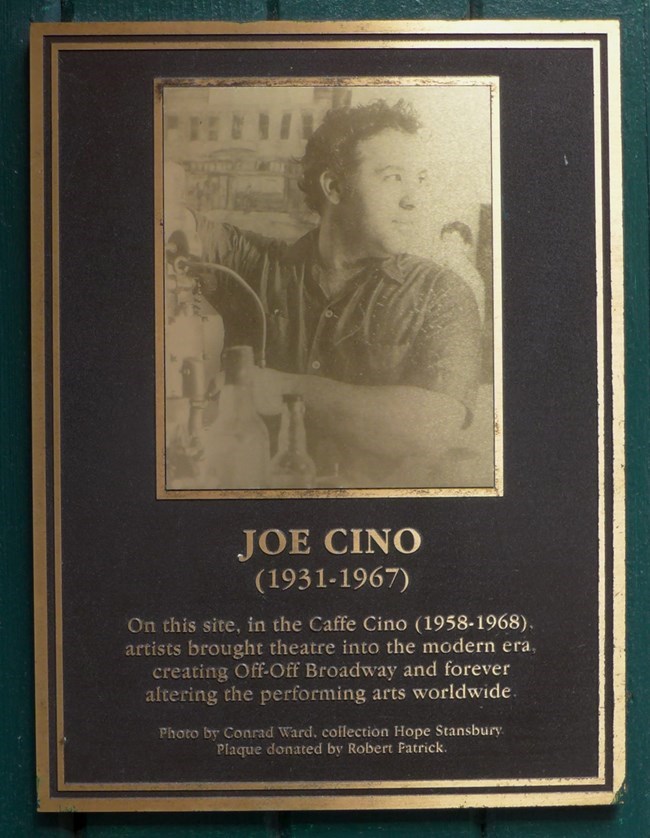Last updated: February 20, 2025
Article
Caffe Cino: Birthplace of Off-Off Broadway

NPS Photo/ John Warren
"It's magic time!"
Joe Cino (pronounced chino) built the tiny stage for Caffe Cino out of milk cartons and carpet remnants. His lover, Jon Torrey, wired the lighting to make the most of the cramped space.1
Cino, born in Buffalo, New York to working class Sicilian immigrants, started his coffeehouse at 31 Cornelia Street in 1958. He had at first intended to feature poetry readings like many places in Greenwich Village. In time, play readings were added to the bill. The idea grew into a theater, even though Cino had no theater license and an impossibly small space.2
He introduced shows by jingling nearby wind chimes and saying, “It’s magic time!” Sometimes no customers showed up for magic time, but Cino insisted that actors perform anyway. He said, “Do it for the room,” and they did.3
Despite his past work in the arts world as a dancer, Cino was an unlikely theater operator. He generally did not read the plays people wanted to put on in his space. Instead, he asked the writer for his astrological sign.4 If he liked the answer, he gave them a date for their production. He was constantly busy, not only with the Caffe but with working other jobs to make ends meet and to "pay off" police however he could, since he was operating a theater without a cabaret or liquor license.5
During its ten years, the coffeehouse pioneered “Off-Off Broadway,” where truly underground content could be explored. Many plays contained gay content at a time when depicting homosexuality onstage was illegal.6 The location also gave gay people a place besides a bar to be themselves, but with one advantage over bars: there was something to do besides drink.7 For the price of a cup of coffee, patrons could be themselves, embracing all their own complexities. The Caffe may have been the origin of an American gay theater, but it was never confined to a single idea of what it was to be gay.
Caffe Cino hosted plays by openly gay playwrights such as Doric Wilson as well as authors whose later works are better known than their work at Caffe Cino: John Guare (Six Degrees of Separation), Tom Eyen (Dreamgirls), Sam Shepard (True West), Robert Patrick (Kennedy’s Children). The Magic of Lady Bright, a 1964 play by Lanford Wilson about an aging “queen,” was considered Caffe Cino’s breakthrough. The 1966 musical Dames at Sea! (or Golddiggers Afloat), starring a teenage Bernadette Peters, was its most popular production.8 Actors for Caffe Cino productions included Harvey Keitel, Al Pacino, and Fred Willard.9 Another Caffe Cino actor was Jim Fouratt, who was at the Stonewall Inn during the riots and was an early gay activist.10
After his lover Torrey died unexpectedly, Cino's life spiraled out of control. His volatility and use of drugs increased. On March 30, 1967, Cino attempted suicide. Although people lined the streets around St. Vincent’s Hospital to give blood, Cino died of peritonitis on Torrey’s birthday, April 2.11 The Caffe finally shut down the following year.
The tactics of early gay activists in the Gay Liberation Front and Gay Activist Alliance were overtly theatrical, influenced perhaps by the vigor and freedom of Off-Off Broadway. Life was imitating art. “Magic time” indeed!
Footnotes
1 Wikipedia, "Joe Cino," accessed August 22, 2019.
2 WarholStars.org, "Caffe Cino," accessed August 22, 2019.
3 Wikipedia, "Joe Cino," accessed August 22, 2019.
4 In the Life, "Caffe Cino," accessed on YouTube August 22, 2019.
5 AtlasObscura.com, "The Gay Coffehouse Where Off-Off Broadway Was Born: Remembering the Caffe Cino of 31 Cornelia Street, New York," accessed August 22, 2019.
6 NYC LGBT Historic Sites Project, "Caffe Cino," accessed August 22, 2019.
7 In the Life, "Caffe Cino," accessed on YouTube August 22, 2019.
8 Wikipedia, "Joe Cino," accessed August 22, 2019.
9 New York Innovative Theatre Awards, "Remembering Joe and the Caffe Cino by Robert Patrick," accessed August 22, 2019.
10 The Villager, "The Faces of Jim Fouratt," accessed August 23, 2019.
11 In the Life, "Caffe Cino," accessed on YouTube August 22, 2019.
A treasure trove of wonderful photos from the productions at Caffe Cino can be found at "Caffe Cino Pictures," accessed August 22, 2019.
